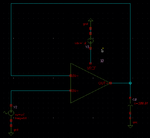thikgaidep
Newbie level 6
hello everyone,
I finished a schematic of single-output folded cascode opamp and did the simulation with it in Cadence. The config of the testbench is that the output of the opamp is connected to its negative input in order to fix the DC point. When I do the Monte Carlo Simulation with 100 samples, there are about 27 abnomal phase responses of the Opamp as follow:
View attachment 123.bmp
it means that in the 27 samples, at low frequencies, the phase is -180 instead of 0 as those of the remain 73 phase responses.
I would like to ask you if my opamp is unstable with those 27 samples or not? And where is the abnomal from, how can I deal with it?
I would be very appreciated. Thank you in advance,
Best regards,
thikgaidep
I finished a schematic of single-output folded cascode opamp and did the simulation with it in Cadence. The config of the testbench is that the output of the opamp is connected to its negative input in order to fix the DC point. When I do the Monte Carlo Simulation with 100 samples, there are about 27 abnomal phase responses of the Opamp as follow:
View attachment 123.bmp
it means that in the 27 samples, at low frequencies, the phase is -180 instead of 0 as those of the remain 73 phase responses.
I would like to ask you if my opamp is unstable with those 27 samples or not? And where is the abnomal from, how can I deal with it?
I would be very appreciated. Thank you in advance,
Best regards,
thikgaidep

